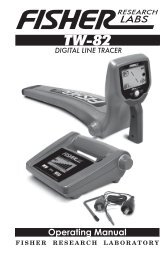Quick Start - Nexcesscdn.net
Quick Start - Nexcesscdn.net
Quick Start - Nexcesscdn.net
You also want an ePaper? Increase the reach of your titles
YUMPU automatically turns print PDFs into web optimized ePapers that Google loves.
4 How Metal<br />
The Unique Technology<br />
5<br />
Detectors Work<br />
of the Explorer SE<br />
Metal detectors create an electromag<strong>net</strong>ic<br />
(EM) field, which pe<strong>net</strong>rates<br />
the ground. Because metal is conductive<br />
it causes a change in this field. The<br />
detector senses this change and sends a<br />
signal back to the control box, alerting<br />
the operator.<br />
Metal detectors can determine the<br />
size, shape and composition of metallic<br />
objects beneath the coil. Typically,<br />
the larger the object, the easier it is to<br />
detect.<br />
A metal detector’s EM operating<br />
frequencies are measured in kilohertz<br />
(kHz).<br />
Low frequency EM fields (e.g. 1.5 kHz)<br />
deeply pe<strong>net</strong>rate the ground, but<br />
sensitivity to smaller targets is low.<br />
High frequency EM fields have a more<br />
shallow depth of pe<strong>net</strong>ration but<br />
sensitivity to small targets is high.<br />
The Explorer SE’s multiple frequency<br />
operation provides the advantage of<br />
both.<br />
Full Band Spectrum (FBS)<br />
Most detectors on the market operate<br />
on a single or dual frequency, ranging<br />
from 1 to 70 kilohertz (kHz)<br />
Although this technology has served the<br />
industry well for years, Minelab found<br />
that a frequency that worked well in one<br />
area would often offer only marginal<br />
performance when used in another<br />
location. Ground mineralisation, trash<br />
content, and target size all had an effect<br />
on how effective a detector transmitting<br />
a single frequency would operate.<br />
Full Band Spectrum technology<br />
combines Minelab’s existing multiple<br />
frequency BBS technology with a<br />
powerful new microprocessor to give:<br />
> greater detecting depth<br />
> high sensitivity over a wide range of<br />
targets<br />
> less interference from electromag<strong>net</strong>ic<br />
sources<br />
> more accurate identification of target<br />
characteristics.<br />
The Full Band Spectrum (FBS) circuit<br />
automatically transmits multiple<br />
frequencies simultaneously. This<br />
increased frequency range means that<br />
the signal received from the detector<br />
coil is analyzed from a wide range of<br />
responses. This allows the Explorer SE<br />
to analyse more target information so<br />
that the target identification (ID) is more<br />
accurate.<br />
Minelab’s unique FBS technology means<br />
deep, sensitive, accurate detecting.<br />
Discrimination<br />
Discrimination is the ability of a metal<br />
detector to identify the user’s desired<br />
target (e.g. jewelry) and eliminate<br />
signals from undesirable material (e.g.<br />
nails).<br />
The Explorer SE can be programmed<br />
in a number of ways to discriminate<br />
against unwanted targets in different<br />
types of ground.<br />
(Discrimination Pattern, pg. 32)<br />
Ground Compensation<br />
The Explorer SE uses a sophisticated<br />
approach to the elimination of ground<br />
mineralisation. It uses advanced digital<br />
filtering to eliminate the influence of<br />
ground signals.



